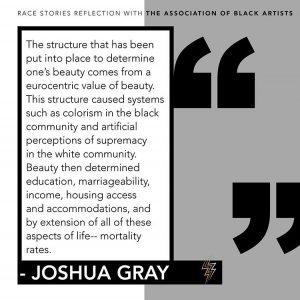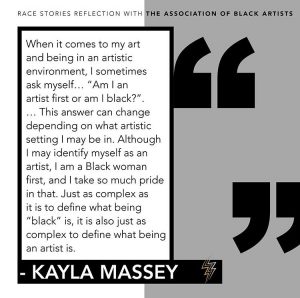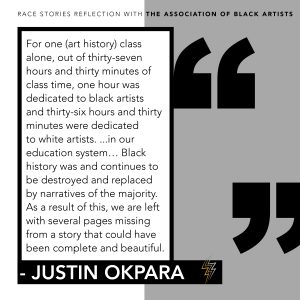The Association of Black Artists’ Reflections on Maurice Berger’s Race Stories
Through July and August of 2020, the CADVC collaborated with the UMBC student-organization, the Association of Black Artists (ABA), to further discussion on Maurice Berger’s Race Stories articles. In their responses, members of ABA reflected on topics such as artist intentionality and curatorial intent, society’s stereotypical definition of beauty, racial identity and one’s identity as an artist, and the education system’s role in gentrification. Here, we’ve archived their reflections and we invite you to reflect on these topics as the CADVC continues to open a dialogue about race in the fields of museum practice and visual art.

Manal Murangi, 2020-2021 ABA Vice President and cinematic artist, reflects on “Holding a Mirror to Race” and discusses artists’ intentionality when prompting viewers to reflect on their art, how curatorial intent contributes to the larger issue in the art field of curating versions of reality that uphold racism, and the role of and pressure on artists to create work that teaches viewers about history and racial inequality.
Read her full reflection here: ABA Reflection- Manal Murangi
_______
“Framing— and Reflecting— Beauty”

Joshua Gray, 2020-2021 ABA President, Vice President of Student Organizations, and performing artist, reflects on “Framing— and Reflecting— Beauty” and deconstructs the stereotypical ideals of beauty, proposing a new definition of how we see ourselves.
Read his full reflection here: ABA Reflection- Joshua Gray
_______
“One Drop, but Many Views on Race”

Kayla Massey, 2020-2021 ABA Events Coordinator and performing artist, reflects on “One Drop, but Many Views on Race” and discusses how racial identity is connected to one’s identity as an artist and what it means to her to be Black, female, and an artist.
Read her full reflection here: ABA Reflection- Kayla Massey
_______
“On the Streets of Harlem, a Sense of Erase and Replace”

Justin Okpara, 2020-2021 ABA Secretary and visual artist, reflects on “On the Streets of Harlem, a Sense of Erase and Replace” and discusses the education system’s role in gentrification and deliberate disregard of Black narratives in core curriculum courses, redlining and gentrification in Baltimore, and his role as an artist to address racial issues in his work.
Read his full reflection here: ABA Reflection – Justin Okpara